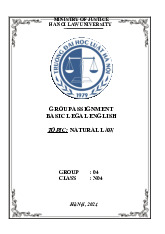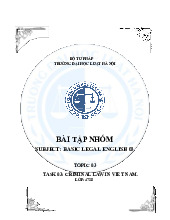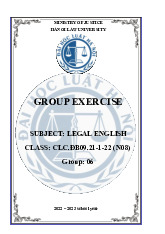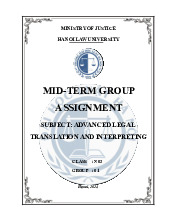












Preview text:
lOMoAR cPSD| 58412604 BỘ TƯ PHÁP
TRƯỜNG ĐẠI HỌC LUẬT HÀ NỘI BÀI TẬP NHÓM MÔN: TIẾNG ANH PHÁP LÝ
ĐỀ B ÀI:
“THE COURT SYSTEM OF VIET NAM” LỚP : NHÓM : 05 Hà Nội, 2023 lOMoAR cPSD| 58412604 MỤC LỤC
1. Overview of the court system......................................................................... 1
2. Function of the court system .......................................................................... 1
3. Organizational structure and jurisdiction of courts at all levels ............... 2
3.1. The Supreme People's Court ...................................................................... 3
3.2. High People's Court ................................................................................... 3
3.3. People's Court of provinces and centrally-run cities ................................. 4
3.4. People's courts of districts ......................................................................... 5
3.5. Military Courts ........................................................................................... 5
4. Some constitutional principles on court operations .................................... 6
4.1. Trial with assessor’s participation ............................................................. 6
4.2. Public trial .................................................................................................. 7
4.3. Collective trial and majority decision ........................................................ 7
4.4. The two-tier trial regime ............................................................................ 8
5. Problems put for the court system ................................................................ 9
DANH MỤC TÀI LIỆU THAM KHẢO ........................................................ 11 lOMoAR cPSD| 58412604 1
THE COURT SYSTEM OF VIETNAM
1. Overview of the court system
The People’s Courts are the judicial bodies of the Socialist Republic of
Vietnam and exercise judicial power. The People’s Courts have the duty to
safeguard justice, human rights, citizen’s rights, socialist regime, interests of the
State, and the lawful rights and interests of organizations and individuals.1
The People’s Court system of Vietnam consists of: The Supreme People’s Court;
High People’s Courts (3 High Courts for the North, Centre and South of Vietnam);
People’s Court of provinces (63 Provincial Courts);
People’s Court of districts (702 District Courts); Military Courts (3 types).2
2. Function of the court system
The Court is a separate organ system in the state apparatus of the Socialist
Republic of Vietnam, assigned state power to perform the function of adjudicating
disputes in society, also known as the function of exercising judicial power. The
judicial function of the court is performed in two aspects:
First, in the current state apparatus of the Socialist Republic of Vietnam, the
judicial function is only given to the court, just like the legislative functions are
vested only in the National Assembly and executive functions are vested in the
Government. In other words, the State's right to judge social disputes is only given
to the courts. The court's ruling carries state power and is binding, even for state
agencies. In practice, there is still a phenomenon where people have the habit of
bringing their disputes to "ask" state administrative agencies to resolve, for
1 Article 102 of the 2013 constitution of the Socialist Republic of Viet Nam.
2 Council of ASEAN Chief Justices. (n.d.-b). Overview of judicial system. CACJ. https://cacj
ajp.org/vietnam/judiciary/overview-of-judicial-system/ lOMoAR cPSD| 58412604 2
example, disputes between apartment buyers and investors are brought to
construction inspection, and land disputes are brought to the Commune People's
Committee... However, this is just a habit because state administrative agencies
are often the agencies closest to the people; The agency that actually has the
function of resolving such disputes is the court, not state administrative agencies.
Second, the court is a professional judicial agency. The court's current
jurisdiction includes criminal, civil, marriage and family, business, commercial,
labor, and administrative cases. In a criminal case, one side is the State,
represented by the People's Procuracy, accusing one or several subjects of
committing a criminal offense; the other side is the defendant and their lawyers.
In civil, marriage and family, business, commercial, and labor cases, private
subjects, which can be individuals or organizations, have a dispute with another
private subject that has violated their rights or legitimate interests. In an
administrative case, a private entity, which can be a citizen or a business, sues a
state administrative agency for violating the law when performing
administrative acts affecting their legitimate rights and interests. So, the current
court system has the authority to adjudicate most types of disputes in society, from
disputes between private parties to lawsuits against state administrative agencies
and criminal cases. There are only a few disputes that do not fall under the court's
jurisdiction, for example, disputes over the constitutionality and legality of legal documents.3
3. Organizational structure and jurisdiction of courts at all levels
In the Vietnamese legal system, the People's Court is the judicial organ of
the Socialist Republic of Vietnam, exercising judicial power. Have the task of
protecting justice, human rights, citizens' rights, protecting the socialist regime,
protecting the interests of the State, and the legitimate rights and interests of
organizations and individuals.
3 Trường Đại học Luật Hà Nội, Giáo trình Luật Hiến pháp, Nxb. Tư pháp, Hà Nội, 2020, tr 492,493. lOMoAR cPSD| 58412604 3
Pursuant to the 2014 Law on Organization of Courts, courts in our country
are divided into the following levels: - The Supreme People's Court; - High People's Courts;
- People's Courts of provinces and centrally-run cities;
- People's court of districts;- Military courts.
3.1. The Supreme People's Court
The Supreme People's Court is the highest judicial organ of the Socialist
Republic of Vietnam, exercising cassation, reviewing effective judgments and
decisions of courts at all levels that have been appealed in accordance with law.
In the organizational structure of the Supreme People's Court, the Council of
Judges of the Supreme People's Court is the body empowered to adjudicate and
issue resolutions guiding courts at all levels to uniformly apply the law.
Mechanism of approval of the Council of Judges: stemming from the
principle of collective trial and majority decision of the People's Court, the
meeting of the Council of Judges must have at least 2/3 of the total number of
members participating; decisions of the Council of Judges must be approved by
more than half of the total number of voting members.
The decision of the Council of Judges on cassation and retrial is the highest
decision, not subject to appeal.
3.2. High People's Court
The High People's Court is a new level of court added in the Law on
Organization of People's Courts 2014 which took effect on June 1, 2015.
Currently, the country has 3 High People's Courts located in Hanoi, Da Nang and
Ho Chi Minh City. It can be seen that the High People's Court performs both the
functions of cassation and retrial like The Supreme People's Court.
The High People's Court has the function of hearing appeals of judgments
and decisions of first instance of high-level People's Courts or centrally-run cities lOMoAR cPSD| 58412604 4
within the scope of territorial competence that have not yet had the force of law
for appeals or appeals in accordance with the procedural law; cassation directors,
re-examine legally effective judgments and decisions of People's Courts of
provinces, centrally-run cities, People's Courts of districts, provincial towns and
cities and equivalents within the territorial competence under appeal in
accordance with the procedural law.
In the structure of the High People's Court, the Committee of Judges of the
High People's Court is the body empowered to organize trials, discuss and
comment on reports of the Chief Judge of the High People's Court.
The meeting of the Committee of Judges must be attended by at least 2/3 of
the total number of members, the decision of the Committee of Judges must be
approved by more than half of the total number of voting members.
3.3. People's Court of provinces and centrally-run cities
The People's Court of the province shall perform the function of first
instance trial of cases within its competence in accordance with the procedural
law; appeal judgments and decisions of district People's Courts that have not yet
taken legal effect that are appealed or appealed in accordance with the procedural
law; examine legally effective judgments and decisions of district People's Courts
when detecting violations of law or new circumstances, and propose them to the
Chief Judge of the High People's Court and the Chief Justice of the Supreme
People's Court to consider appeals.
The People's Court of the province is a local court, so it is given great
authority by law in adjudicating and settling cases.
In the People's Court of the province, there are specialized courts: criminal
court, civil court, administrative court, economic court, labor court, family and
juvenile court established to directly settle cases. lOMoAR cPSD| 58412604 5
3.4. People's courts of districts
When adjudicating and settling cases, district People's Courts only have
jurisdiction to settle first-instance cases within their competence in accordance with the procedural law.
At the district level, specialized courts shall be established only at the request
of the Chief Justice of the Supreme People's Court, at the request and practice of
trial in each district People's Court. 3.5. Military Courts
The levels of Military Courts include: - Central Military Court;
- Courts of Military Zones and Equivalents;- Courts of Military Regions.
When determining jurisdiction under a case, Military Courts only participate
in the settlement of criminal cases according to the jurisdictional delimitation of
the Code of Criminal Procedure. Accordingly:
- Courts of Military Regions have the function of hearing criminal cases
atfirst instance in accordance with the provisions of the Code of Criminal Procedure;
- Courts of Military Zones and Equivalents have the function of firstinstance
trial of criminal cases in accordance with the provisions of the Code of Criminal
Procedure; appellate adjudication of criminal cases in which judgments or
decisions of first instance of regional military courts have not yet taken legal effect are appealed;
- The Central Military Court has the function of appealing criminal casesin
which the judgments and decisions of the first instance of the Courts of Military
Regions and its equivalent have not yet taken effect and are appealed.
Thus, the Military Courts only stop at the level of appellate hearing of
criminal cases in which the judgment or decision of first instance has not yet taken lOMoAR cPSD| 58412604 6
effect and is appealed against. Cassation and retrial remain within the functions
of the High People's Court and the Supreme People's Court.
4. Some constitutional principles on court operations
4.1. Trial with assessor’s participation
The court’s trial with the assessor's participation is provided for by the
Constitution. This constitutional principle is concretized in Clause 1, Article 103,
Constitution 2013: “Except in the case of trial by summary procedure, Assessors
shall participate in first-instance trials by the People’s Courts.”
People’s assessors and military assessors are those who live, work or
participate in daily social activities within population communities and are
elected or appointed to participate in trial activities. They bring to court sessions
people’s opinions on cases, helping courts handle them in an accurate and just
manner. With their rich experience in life and professional knowledge, assessors
make important contributions to clarifying and affirming the truth of cases.
In trial, assessors are equal in rights to judges. All matters related to cases
must be jointly discussed and approved by judges and assessors in deliberation
rooms. Assessors are equal to judges in examining circumstances as well as in deciding on judgments.
In order to ensure the assessor’s effective participation in trial, the law
provides that state bodies, social organizations, and localities where assessors
work or reside must create favorable conditions for them to properly perform their
tasks while assessors must raise their legal knowledge and sense of responsibility in adjudication at court.
This is an extremely important principle contributing to the consolidation of
the relationship between courts and people, the guarantee of accuracy and justice
in trial activities, education in the sense of law and crime prevention. lOMoAR cPSD| 58412604 7 4.2. Public trial
Publicity is a property of a democratic regime. In general justice, publicity
is expressed as a guiding principle, which is acknowledged by the Constitution.
It is concretized by Clause 3, Article 103, Constitution 2013 as follows: “The
People’s Courts shall hold their hearings in public. In a special case which
requires protection of state secrets, conformity with the fine customs and
traditions of the nation, protection of minors or protection of private life and at
the legitimate request of an involved party, the People’s Court may hold a closed hearing.”
Public trials may be carried out in the adjudication rooms at courts’
headquarters or in an itinerant manner at places where crimes are committed or
the accused’s places of residence, if it is deemed necessary. Contents, time, and
venues of such court sessions must be publicly posted up before adjudication and
the adjudication procedures and results can be publicized to people on the mass media.
The public-trial principle is applied not only to first-instance trials but also to appellate trials.
The public trial constitutes a guarantee, enabling people to inspect and
supervise adjudicating activities of courts, and at the same time promote the effect
of education and crime prevention. It also aims to heighten the responsibilities of
judges, prosecutors, people’s assessors and counsels to perform their respective
tasks and strictly comply with law.
4.3. Collective trial and majority decision
This is also a constitutional principle clearly stated in Clause 4, Article 103,
Constitution 2013: “Except in the case of a trial by summary procedure, the
People’s Courts shall try cases on a collegial basis and make decisions by a vote of the majority”. lOMoAR cPSD| 58412604 8
Court trials are conducted by trial panels set up under law. A trial panel is
composed of one judge and two assessors or two judges and three assessors if a
case is serious and involves complicated circumstances. An appellate trial panel
is composed of three judges and possibly two assessors when necessary. A
cassation or re-opening trial panel is composed of at least three judges.
Upon trial, the trial panel members will settle all matters related to the case
one by one by majority vote, with judges making their votes finally. Persons
holding minority opinions may reserve their opinions in case files.
The principle of collective trial and decision by majority aims to ensure the
all-sidedness and objectiveness in examining and assessing circumstances of
cases, thus passing just and correct verdicts while avoiding subjectivity,
arbitrariness and casualness in trial activities.
4.4. The two-tier trial regime
This constitutional principle is concretized in Article 6, Law on Organization
of People's Courts 2014: “The first-instance and appellate trial system shall be
guaranteed.”, courts shall follow the regime of two-tier trials: the first-instance
trial and the appellate trial.
First-instance judgments and decisions, if not being appealed or protested
against, will be legally valid. For first-instance judgments or decisions which are
appealed or protested against, the cases must be brought to appellate trial and the
appellate judgments and decisions shall be legally valid. For legally valid court
judgments and decisions, if law violations are detected or new circumstances
emerge, they will be reviewed according to the cassation or reopening procedures.
The first-instance trial means the adjudication of such cases at the first and
most fundamental level, which is compulsory for any case.
The appellate trial is the second tier of trial by superior courts which directly
re-adjudicate first-instance judgments and decisions, which are yet legally valid
and appealed or protested against. lOMoAR cPSD| 58412604 9
The implementation of a two-tier trial regime aims to ensure the lawfulness
and groundedness of court judgments and decisions, ensuring that wrong
judgments or decisions will not be enforced. This also constitutes a mode of
supervision by superior courts over adjudicating activities of subordinate courts,
protecting the legitimate rights and interests of the accused, victims, plaintiffs, and defendants.4
5. Problems put for the court system
According to the Supreme People’s Court, all levels of the court system are
facing various difficulties. Particularly, the number of criminal cases, commercial
disputes, and civil lawsuits requiring court settlement is increasing, with cases
expanding in scale and complexity, while the number of judges and staff of the
court remains very limited, leading to an overload of cases compared to the
court’s capacity. In addition, the working conditions and facilities of the courts
are still subpar or lacking, and not enough attention has been paid to ensuring they
properly meet the functions and tasks of the people’s courts. The remuneration
regime for judges and other judicial positions is not satisfactory compared to their
working capacity, responsibilities, and occupational risks.
Vietnam’s court system is independent of the legislative and executive
bodies, not belonging to the government or to ministerial-level agencies or
branches. However, the mechanism for allocating funds to the court depends on
the government, which leads to a prolonged process of approving the budget,
limiting the proactive management and use of the court’s budget in implementing
the law. In particular, this mechanism also leads to a misperception about the role
of the court, affecting its independence.
To solve this problem, the Supreme People’s Court must consider increasing
the number of judges and building a system of budget equalization transfers from
4 https://vietnamlawmagazine.vn/basic-principles-of-criminal-procedure-law-4426.html. lOMoAR cPSD| 58412604 10
the central to the provincial courts. This effort will hopefully decrease the number of pending suits in court. lOMoAR cPSD| 58412604 11
DANH MỤC TÀI LIỆU THAM KHẢO 1. Basic principles of criminal procedure law (2009) vietnamlawmagazine.vn.
https://vietnamlawmagazine.vn/basic-principles-of
criminal-procedure-law-4426.html (Accessed: 12 October 2023). 2.
Council of ASEAN Chief Justices. (n.d.-c). Vietnam.
CACJ.https://cacj-ajp.org/vietnam/. 4.
Giang Hoang Bach. (2023, February 24). Vietnam: Law on
organizationof people’s courts under review for future amendment. Tilleke & Gibbins.
https://www.tilleke.com/insights/vietnam-law-on-organization-of-peoplescourts- under-review-for-future. 5. Law on organization of People’Courts.
https://thuvienphapluat.vn/vanban/EN/Bo-may-hanh-chinh/Law-No-62-2014-
QH13-on-organization-ofpeople-s-courts/267272/tieng-anh.aspx 6.
The 2013 constitution of the Socialist Republic of Vietnam (2014) vietnamlawmagazine.vn.
https://vietnamlawmagazine.vn/the-2013-
constitutionof-the-socialist-republic-of-vietnam-4847.html. 7.
Trường Đại học Luật Hà Nội, Giáo trình Luật Hiến pháp, Nxb. Tư pháp,Hà Nội, 2020.




